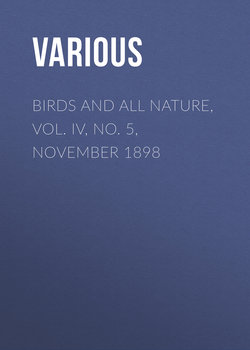Читать книгу Birds and All Nature, Vol. IV, No. 5, November 1898 - Various - Страница 1
NATURE'S ORCHESTRA
ОглавлениеALL nature is attuned to music. Man may seek the fields, the forests, the mountains, and the meadows, to escape from distracting noises of the city, but nowhere, not even in the depths of mountain forests, will he find absolute silence. And well for him that it is so, for should no noise, no vibration of the air greet his accustomed ear, so appalling would be the dead silence that he would flee from it as from the grave.
Even the Bugs make music. They may not be much as vocalists but they take part in nature's symphony with the brook, the Bird, and the deep diapason of the forest monarch swaying and humming to the gusts of the wayward wind. It is true that the great majority of our species of insects are silent, and those which do make sounds, have not true voices, breathing as they do through holes arranged along each side of their body, and not through their mouths, they naturally possess no such arrangement for making noises connected with breathing as we find in the human larynx.
The "buzzing Fly" and "droning Bee" are classed among nature's musicians, as well as the Cicadas, Grasshoppers, Crickets, Locusts, Katydids, and Beetles. Only the males are the musicians in the insect families – with the exception of the Mosquito, the lady being the musical member of that family – and the different kinds of Grasshoppers are provided with an elaborate musical apparatus by means of which they call their mates.
Chief among the insect performers is the Cicada, often confused with the Locust, though he does not belong to that family at all, who possesses a pair of complicated kettle-drums, which he plays with his muscles instead of sticks.
Directly behind the base of each hind leg is a circular plate of about one-quarter of an inch in diameter. Beneath each of these is a cavity across which is stretched a partition of three membranes. At the top is a stiff, folded membrane, which acts as a drum-head. Upon this he plays with his muscles, the vibrations being so rapid that to the ears of some listeners the noise, or music he engenders, sounds more like that of a mandolin than a drum. He is a black fellow with dull green scroll work over his thick body, lives in trees, and is generally invisible when he plays the drum.
The Grasshopper is the fiddler of the great orchestra, and the hotter the day the more energetically does he fiddle. The fellow with the short horns has a rough hind leg which he uses as a bow; this he draws across the wing cover, giving off the notes which he so dearly loves. Near the base of each fore wing is a peculiar arrangement of veins and cells. This arrangement differs in the different species, but in each it is such that by rubbing the fore wings together they are made to vibrate, and thus, some naturalists aver, they make the sounds which we hear.
The most easily observed of all insect musicians are the common Crickets. By placing a sod of growing grass in a cage with several male crickets, you can watch them play upon their fiddles. Upon the lower side of their wings you will see ridges like those of a tiny file, and on the inner margin toward the base from the end of the principal vein, a hardened portion, which may be called the scraper. By using the files and scrapers of their fore wings the little musicians add their notes to the universal music of the world. Ellanora Kinsley Marble.
